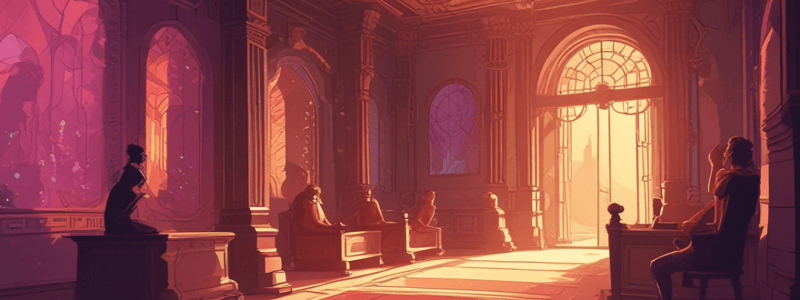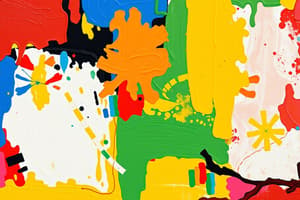Podcast
Questions and Answers
What is the effect of cool hues on the viewer?
What is the effect of cool hues on the viewer?
- They have a neutral effect on the viewer.
- They appear heavy and aggressive.
- They recede and suggest sky, water, distance, foliage, and shadows. (correct)
- They advance and suggest sunlight, heat, and blood.
What is the result of adding gray to a pure hue?
What is the result of adding gray to a pure hue?
- The color becomes more vivid.
- A tint is created.
- The saturation of the color is reduced. (correct)
- A shade is created.
Which color temperature is associated with red-orange?
Which color temperature is associated with red-orange?
- Warm (correct)
- Cool
- Bright
- Neutral
What is the term for the lightness or darkness of a color?
What is the term for the lightness or darkness of a color?
What is the result of adding white to a color?
What is the result of adding white to a color?
What is the term for the intensity or brightness of a color?
What is the term for the intensity or brightness of a color?
What is the effect of warm hues on the viewer?
What is the effect of warm hues on the viewer?
What is the term for a step of change between color samples?
What is the term for a step of change between color samples?
What is the term used to describe the visual agreement of all parts of a work?
What is the term used to describe the visual agreement of all parts of a work?
Which of the following color harmonies involves using different hues of the same color?
Which of the following color harmonies involves using different hues of the same color?
What is the term used to describe colors that are more advancing and tend to come forward?
What is the term used to describe colors that are more advancing and tend to come forward?
What is the term used to describe the point at which an individual can no longer detect a difference between two close samples?
What is the term used to describe the point at which an individual can no longer detect a difference between two close samples?
Which of the following color properties makes a color more receding?
Which of the following color properties makes a color more receding?
What is the term used to describe the use of conflicting, unrelated colors?
What is the term used to describe the use of conflicting, unrelated colors?
What is the term used to describe a series of progressive intervals that are so close that individual steps cannot be distinguished?
What is the term used to describe a series of progressive intervals that are so close that individual steps cannot be distinguished?
What is the term used to describe the ability to detect differences between wavelengths of light?
What is the term used to describe the ability to detect differences between wavelengths of light?
What is a complementary hue in a color wheel?
What is a complementary hue in a color wheel?
What does the vertical axis of the three-dimensional color wheel represent?
What does the vertical axis of the three-dimensional color wheel represent?
Who developed the color sphere and 'star' for his Bauhaus preliminary course?
Who developed the color sphere and 'star' for his Bauhaus preliminary course?
Why did Johannes Itten place yellow at the top of his color diagram?
Why did Johannes Itten place yellow at the top of his color diagram?
What shape did Josef Albers use in his teaching diagram?
What shape did Josef Albers use in his teaching diagram?
What is a characteristic of Josef Albers' paintings?
What is a characteristic of Josef Albers' paintings?
What is the purpose of a color wheel?
What is the purpose of a color wheel?
What do the horizontal intervals on the color wheel represent?
What do the horizontal intervals on the color wheel represent?
What do the two characters following the # symbol represent in the RGB color system?
What do the two characters following the # symbol represent in the RGB color system?
What is the maximum value of each color component in the RGB color system?
What is the maximum value of each color component in the RGB color system?
What is the purpose of calibrating a monitor?
What is the purpose of calibrating a monitor?
What is the Pantone Color Matching System used for?
What is the Pantone Color Matching System used for?
What is the result of the absorption of light by a surface?
What is the result of the absorption of light by a surface?
What is the process by which light changes direction when it hits a rough surface?
What is the process by which light changes direction when it hits a rough surface?
What happens when light passes from one medium to another with a different speed?
What happens when light passes from one medium to another with a different speed?
What is the term for the measurable property of how materials interact with light?
What is the term for the measurable property of how materials interact with light?
What is the minimum requirement for color to occur?
What is the minimum requirement for color to occur?
What determines the color effect of an object?
What determines the color effect of an object?
What is the range of the visible spectrum?
What is the range of the visible spectrum?
What is the term for when two objects appear to match under one light source but not another?
What is the term for when two objects appear to match under one light source but not another?
What is the unit of measurement for wavelengths of light?
What is the unit of measurement for wavelengths of light?
What happens when white light passes through a prism?
What happens when white light passes through a prism?
What is the term for the distance between peaks of light energy emissions?
What is the term for the distance between peaks of light energy emissions?
What is the factor that affects the way we perceive color?
What is the factor that affects the way we perceive color?
Study Notes
Color Theory and Lighting
- The light wheel is used for theatrical lighting and projection, and is the basis for video and computer graphics.
- Color Temperature: Cool hues (blue-green) recede and suggest sky, water, distance, foliage, shadows; warm hues (red-orange) advance and suggest aggression, sunlight, heat, blood, arousal, and stimulation.
Color Properties
- Value: Lightness and darkness of a color.
- Tint: A color with the presence of white; a lighter shade of a color (e.g., pink is a tint of red).
- Shade: A color with the presence of black; a darker shade of a color (e.g., navy is a shade of blue).
- Saturation: Intensity, brightness, or dullness of a color; tone is the addition of gray to pure hue.
- Dilution: Changing a pure hue by lightening, darkening, or muting using additives such as white, black, gray, or its complement.
- Transparence: The impression of transparency can be achieved when two sets of colors are joined by a third that is perfectly balanced between them.
- Gradient: A series of progressive intervals that are so close that individual steps cannot be distinguished; a seamless transition between color differences.
- Threshold: The point at which an individual can no longer detect a difference between two close samples.
- Visual Acuity: The ability to detect differences between wavelengths (colors) of light.
Color Harmony
- Color Harmony: The visual agreement of all parts of a work; also called Color Chords.
- Types of Color Harmony: Monochromatic, Analogous, Direct Complementary, Near-Complementary, Split Complementary, Double Complementary, Triadic, Tetradic, Achromatic, and Neutral.
Color Systems
- Partitive Color: Based on the viewer's reaction to colors when they are placed next to each other.
- Subtractive Color: The process of mixing pigments together, such as in paintings; used in RGB or Light Wheel.
- Additive Color: Used in color displays, such as computer monitors.
- Pantone Color Matching System: A standardized color reproduction system.
Color and Lighting
- Transmission: The mostly unimpeded passage of light through a transparent object.
- Reflection: The process by which light arriving at a smooth-surfaced material changes direction on impact and is returned.
- Absorption: The absorption of light occurs when a ray of light strikes a surface, transferring energy to the surface material.
- Scattering: Refers to the change of direction suffered by radiation on impact with a rough-surfaced material or with fine particles.
- Refraction: The bending of a beam when it enters a medium where its speed is different.
Color Theory
- How We See Color: Color is a mental sensation that can only occur if there is an observer, an object, and sufficient light in the narrow band of wavelengths called the visible spectrum.
- Electromagnetic Spectrum: The entire electromagnetic spectrum is not perceivable to humans; what we see we call the "visible spectrum".
- Wavelengths of Light: Measured in nanometers; the colored light in the visible spectrum ranges from red to violet.
- Munsell Wheel: Arranges colors in a three-dimensional form with intervals of value, measuring lightness and darkness, on the vertical axis, and saturation or relative purity of each hue on the horizontal intervals.
Color Icons
- Johannes Itten: Developed the color sphere and "star" for his Bauhaus preliminary course; placed yellow at the top of the diagram because it was the brightest of the hues and closest visually to white light.
- Josef Albers: Used a triangle diagram with red, yellow, and blue at its points; orange, violet, and green at the midpoints, with red-gray, yellow-gray, and blue-gray in between.
Studying That Suits You
Use AI to generate personalized quizzes and flashcards to suit your learning preferences.
Description
This quiz covers the basics of color temperature in theatrical lighting, including cool hues and warm hues, and their effects on the audience.





